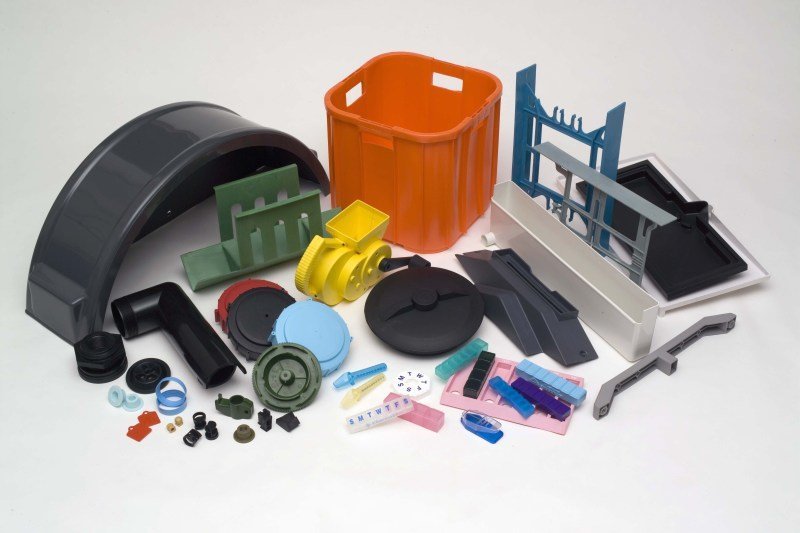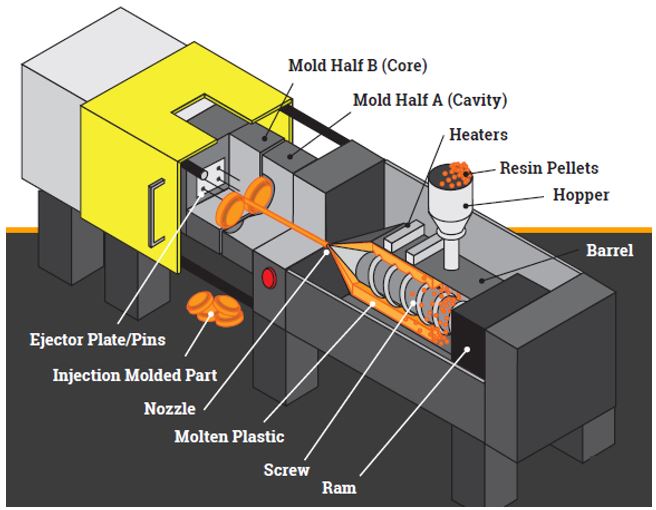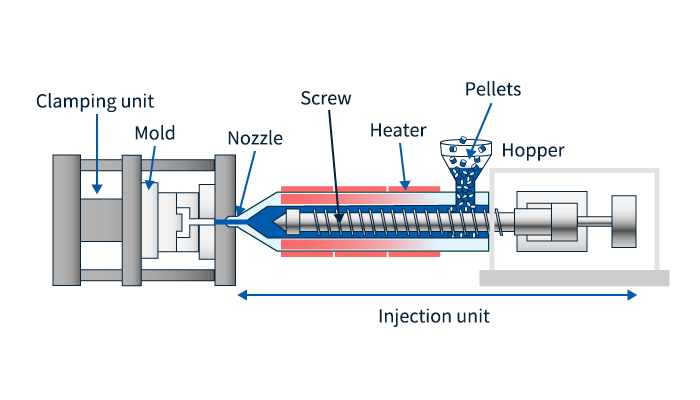The Duty of Plastic Injection Molding in Creating Cost-Effective Industrial Parts
The Duty of Plastic Injection Molding in Creating Cost-Effective Industrial Parts
Blog Article
Comprehending the Basics of Plastic Injection Molding Procedures
Plastic shot molding serves as a keystone of contemporary manufacturing, giving a systematic method to generating intricate elements with accuracy. Exploring these important components can reveal exactly how even minor adjustments can lead to significant enhancements in manufacturing end results, increasing concerns concerning the capacity for technology in this well established process.
What Is Plastic Shot Molding?
Plastic shot molding is a commonly utilized manufacturing procedure that changes thermosetting and polycarbonate products into specific and complicated shapes. This technique is favored for its capacity to produce high quantities of the same components with outstanding precision, making it a crucial method in numerous markets, including automotive, durable goods, and clinical gadgets.
The process includes thawing the picked plastic product and infusing it into a mold and mildew under high stress. The mold, made to the specs of the preferred part, allows the molten plastic to form as it strengthens and cools down. When the material has set, the mold is opened up, and the finished part is expelled.
Plastic injection molding provides a number of benefits, consisting of reduced waste, consistency in production, and the capability to include elaborate styles that may be testing with various other making methods. Furthermore, it supports a broad variety of materials, each giving unique residential or commercial properties that can be customized for specific applications. As industries continue to introduce, plastic shot molding stays at the forefront, enabling the development of sophisticated products that meet advancing customer needs.
The Shot Molding Refine
The injection molding procedure is a sophisticated technique that entails numerous vital phases to create high-grade plastic parts. Plastic pellets are fed right into a warmed barrel where they are melted right into a thick liquid. This molten plastic is after that infused under high pressure right into a precision-engineered mold and mildew, which forms the material into the preferred type.
Once the mold and mildew is loaded, the plastic is allowed to solidify and cool, taking the form of the mold and mildew dental caries. Cooling time is essential, as it influences the cycle time and the last residential properties of the molded component. After adequate cooling, the mold and mildew opens, and the completed element is ejected making use of ejector pins.

Materials Used in Injection Molding
Various materials can be made use of in the shot molding procedure, each offering special residential or commercial properties that satisfy details applications. One of the most frequently used materials include thermoplastics, thermosetting plastics, and elastomers.

Thermosetting plastics, like epoxy and phenolic materials, undergo a chemical modification during the curing procedure, resulting in a stiff, stringent structure. These products are ideal for applications needing high warmth resistance and structural integrity, frequently made use of in electric insulators and auto parts.
Elastomers, including silicone and rubber-based products, give flexibility and durability. Their one-of-a-kind residential properties make them suitable for applications that demand elasticity, such as seals and gaskets.
In addition, specialized products like bio-based plastics and compounds are gaining traction for their environmental benefits and improved performance attributes, widening the extent of shot molding applications in various industries. Comprehending the buildings of these products is vital for selecting the suitable type for particular projects.
Benefits of Injection Molding
Injection molding stands apart as an extremely reliable manufacturing process that provides various advantages for creating complicated parts with precision. One of one of the most considerable advantages his comment is here is the capability to develop intricate designs that would certainly be impossible or difficult to achieve with other techniques (Plastic Injection Molding). The process enables comprehensive features and limited tolerances, guaranteeing premium elements
Additionally, shot molding is understood for its rapid manufacturing capabilities, making it a perfect choice for high-volume production. When the mold is created, components can be created rapidly, lowering preparations and boosting overall performance. This efficiency not only decreases production prices however also offers an affordable edge in the market.
The flexibility of products used in shot molding additionally improves its allure. A large range of thermoplastics and thermosetting polymers can be utilized, allowing suppliers to choose products that best fulfill their particular needs, including toughness, heat, and adaptability resistance.
Furthermore, the process decreases waste, as excess material can usually be recycled and reused. This sustainability element contributes to a minimized environmental effect, making injection molding an accountable manufacturing option. In general, the advantages of injection molding make it a recommended approach for numerous industries.
Variables Affecting Product Quality
While many elements can influence item top quality in shot molding, comprehending these elements is essential for achieving ideal results. Secret facets include product selection, processing specifications, and mold and mildew style.
Material selection plays a vital function, as various polymers exhibit unique properties that affect flowability, stamina, and thermal stability. Inadequate material choice can bring about problems such as warping or insufficient dental filling.
Processing parameters, including temperature, cycle, and pressure time, must be carefully managed. Variations in these setups can cause inconsistencies partially dimensions and surface coating. Excessively high temperature levels might create destruction of the polymer, while poor stress can result in brief shots.
Mold layout is equally important, as it figures out the circulation of the molten plastic and the cooling procedure. Badly developed mold and mildews might bring about uneven cooling rates, leading to dimensional mistakes and recurring stresses.

Verdict
To conclude, plastic shot molding click this link serves as a critical manufacturing procedure that allows the effective production of top notch components. Proficiency of the injection molding procedure, including the understanding of materials and the impact of numerous aspects on product quality, is important for attaining optimum results. The advantages of this approach, such as cost-effectiveness and layout flexibility, additional underscore its value across numerous sectors, solidifying its status as a recommended option for high-volume manufacturing.
Plastic shot molding offers as a keystone of modern-day manufacturing, supplying a systematic strategy to generating intricate elements with precision.Plastic shot molding provides several advantages, including minimized waste, consistency in manufacturing, and the capability to incorporate intricate styles that may be challenging explanation with various other manufacturing approaches (Plastic Injection Molding). As markets proceed to innovate, plastic shot molding stays at the center, making it possible for the advancement of innovative products that satisfy evolving customer demands
The injection molding procedure is an innovative technique that includes several crucial stages to create high-quality plastic parts.In final thought, plastic shot molding offers as an essential production process that allows the efficient manufacturing of premium components.
Report this page